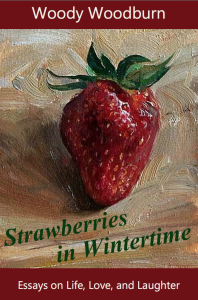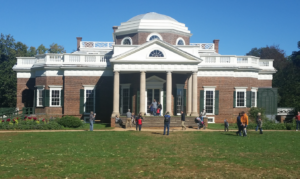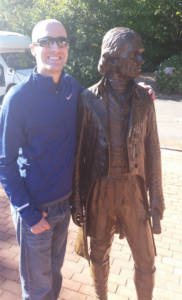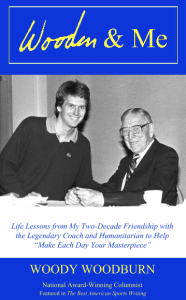 Woody’s highly anticipated new book “STRAWBERRIES IN WINTERTIME: Essays on Life, Love, and Laughter” is NOW available! Order your signed copy HERE!
Woody’s highly anticipated new book “STRAWBERRIES IN WINTERTIME: Essays on Life, Love, and Laughter” is NOW available! Order your signed copy HERE!
* * *
‘Little Mountain’ and Big Heartbreak
This is the second in a four-column series chronicling my recent father-son road trip to the homes of two Founding Fathers and more.
* * *
More than two centuries before the creation of Twitter, Thomas Jefferson distilled his life’s accomplishments into this tweet-length epitaph inscribed on his tombstone:
“Author of the Declaration of Independence, of the Statute of Virginia for Religious Freedom, and Father of the University of Virginia.”
In truth, 140 pages in an encyclopedia would be insufficient to chronicle Jefferson’ genius, much less 140 characters. Still, it is difficult to fathom leaving out mention of being the third president of the United States.
Perhaps a greater omission is this deed: “Designed Monticello.”
Jefferson called Monticello – meaning “little mountain” in old Italian – his “essay on architecture.” The neoclassical mansion was four decades in the making and remains such a masterpiece it is recognized as a World Heritage Site by the United Nations.
Remarkably, Jefferson designed every aspect and angle, inside and out, despite having no formal architectural training.
As with most things that interested him, which means MOST things, Jefferson became an expert by reading extensively – in this case, studying architecture, particularly that of ancient Rome and the Italian Renaissance.

Greg Woodburn, in the flesh, and Thomas Jefferson, in bronze.
A true Renaissance man, his passions ranged from architecture to viticulture, music to bird watching, botany to beer making.
For good reason President Kennedy once famously quipped, at a dinner honoring 49 Nobel Prize winners: “I think that this is the most extraordinary collection of talent, of human knowledge, that has ever been gathered together at the White House, with the possible exception of when Thomas Jefferson dined alone.”
As pleasing as the Declaration of Independence is to the ear, Monticello is to the eye. Viewing the colossal columns and domed rooftop and arched windows from outside is like studying a Monet water scene; the longer you stare, the more perfection you see.
The interior – the grand entry hall filled with Native American artifacts collected by Lewis and Clark, the voluminous library, Jefferson’s bedroom chamber, the dome room above and cellar below – is equally breathtaking.
Too, there are the long and elegant north and south terraces that housed a dairy, smokehouse, kitchen, stables . . .
. . . and slave quarters.
More than being architecture as art, beyond the magnificent panoramic view that extends 45 miles on a clear day, the piece of Monticello that struck me most profoundly is that the man who wrote the Declaration of Independence containing the words “all men are created equal” owned men – and women and children.
Now, I knew Jefferson was a slave owner and that DNA tests support the claim he may have fathered as many as six children with Sally Hemings, a household slave. But these distressing truths do not resonate as deeply and poignantly in two dimensions in a textbook as they do in three dimensions in person.
Indeed, seeing the squalor slave quarters; walking the plantation fields where slaves toiled; hearing that 130 slaves were sold, families torn apart, after Jefferson’s death to pay off his debts, the ugly auction held right here on the lovely West Lawn of the mansion; opened my eyes wider than before.
One final sight – and site – opened my tear ducts as well. It was a graveyard near the parking lot. Not the wrought iron-fenced cemetery containing the tall obelisk tomb of the Founding Father who died on July 4, 1826 – 50 years to the day after the signing of the famous document he drafted – but rather a bare plot scattered with rocks and surrounded by trees, marked with a small sign reading:
“Buried in this graveyard are more than 40 of the nearly 400 men, women, and children who lived in slavery at Monticello from 1770 to 1827. Although the names of Monticello’s enslaved residents are known, it has not been possible to identify the individuals buried here.”
Reflecting in the shade at this unfairly solemn spot, this sinful truth was powerfully clear: “Life, Liberty and the pursuit of Happiness” were not unalienable rights for everyone at Monticello.
* * *
Woody Woodburn writes a weekly column for The Ventura County Star and can be contacted at WoodyWriter@gmail.com.
 Check out my new memoir WOODEN & ME: Life Lessons from My Two-Decade Friendship with the Legendary Coach and Humanitarian to Help “Make Each Day Your Masterpiece”
Check out my new memoir WOODEN & ME: Life Lessons from My Two-Decade Friendship with the Legendary Coach and Humanitarian to Help “Make Each Day Your Masterpiece”
- Personalized signed copies are available at WoodyWoodburn.com
- Unsigned paperbacks or Kindle ebook can be purchased here at Amazon
